Operations
ORIGIN
Much like coffee, consumers are starting to demand transparency with regards to where and how their tea is manufactured. The term ‘single origin’ refers to loose leaf teas which hail from a single geographic region, estate or garden. Such single origin teas bear the closest relationship to the areas in which they’re grown, reflecting the unique combination of soil, climate and geography found there (this is often called ‘terroir’ in the wine industry). According to Dollfuss, three things make a good tea: “Origin, the way it’s plucked and the way it’s manufactured. Pure Leaf is a single origin tea. This matters because each origin has its own flavour characteristics, and at Unilever Food Solutions, we want to preserve these flavour characteristics in our tea.”
STORAGE
Tea is a hydroscopic product and so is prone to absorbing moisture and aromas. It should be stored in an airtight environment away from any strong smelling substances. With time, tea absorbs moisture and this changes its taste and characteristics. The ‘keeping quality’ of teas differ depending on origin and type. Cassidy explains: “Generally Ceylon black teas taste best when consumed within 12 months of packing but for Chinese green teas it can be as little as six months. So it’s best to use tea brands which are single origin and packaged at the source.”
SUSTAINABILITY
La Marquise International is an exclusive distributor of teas from Jafferjee Brothers in the UAE and Oman. Jafferjee Brothers is a tea manufacturer and distributor with tea plantations in Ceylon and production and packaging facilities in Sri Lanka. One of the biggest developments in the industry has been the growth of teas certified under Fair Trade and Rainforest Alliance, ensuring a fair price for farmers and workers. Speaking about their single origin production methods, Cassidy says: “Jafferjee Brothers use only 100% pure Ceylon tea and packages all its teas in Sri Lanka thereby ensuring maximum value addition at origin which tremendously benefits the local economy.
COST VS QUALITY
As a result of new inventory being added in the market, forcing a decline in revenue per available room (PAR) and available room rates (ARR), some hoteliers are looking for ways to reduce cost in order to maintain their bottom line. As a result, decision-making, pertaining to the selection of F&B products is slowly shifting from F&B managers, to purchasing managers who are focused primarily on reducing costs and opting for lower quality items. Premium in-room amenities such as tea and coffee are often the first to go. “While it may offer slight savings in the short term, it will have much greater repercussions in the future, leaving hotel guests as the biggest victim with no choice but to seek other venues where they will experience more value for their money,” says Tariq Aruri, managing partner at Sava Brands.

| Advertisement |





